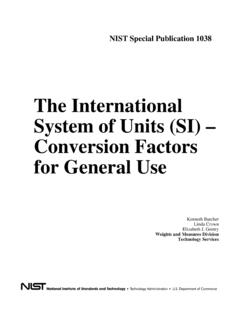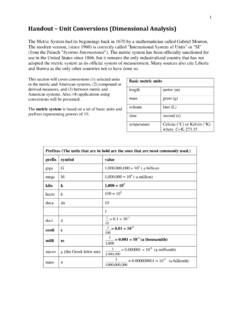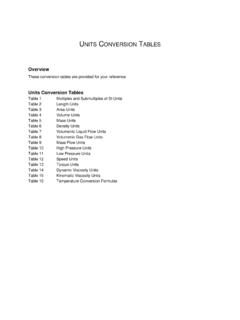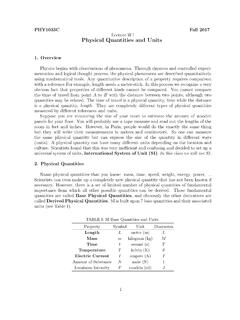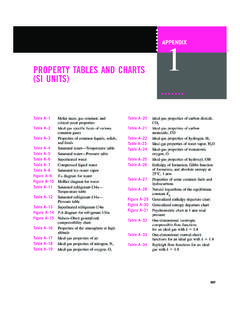Transcription of THE CONCEPT OF VISCOSITY - Columbia University
1 22 CHAPTER 3 THE CONCEPT OF VISCOSITY Fluid flow plays a very important part in the processing of materials. Most processes are based on the use of fluids either as raw materials, reagents, or heat transfer media. In this book, we will see many examples of processes where the rates of heat transfer, mass transfer and chemical reaction between two phases depend on the fluid flow phenomena in the system. It is therefore necessary to start our study of rate phenomena in processing systems by examining the motion of fluids. DEFINITION AND MEASUREMENT OF VISCOSITY The behavior of a fluid in flow is very much related to two intrinsic properties of the fluid: density and VISCOSITY .
2 For example, a solid body moving through a gas has to overcome a certain resistance which depends on the relative velocity between fluid and solid, the shape of the solid, the density of the gas and its VISCOSITY . The power required to move a fluid through a conduit is a function of the fluid velocity, the diameter of the conduit and the fluid density and VISCOSITY . The existence and nature of VISCOSITY can be demonstrated by suspending two horizontal, parallel plates in a liquid so that they are separated by a very small distance, Y (Fig. ). Now, if the upper plate is kept stationary while the lower plate is set to motion with a velocity uo, the layer of liquid right next to this plate will also start to move.
3 With time, the motion of the bottom layer of fluid will cause the fluid layers higher up to also move. 23 As shown in Fig. , when steady-state conditions are established, the velocity of the uppermost layer, which is in contact with the stationary plate, will also be zero, while the bottom layer, in contact with the moving plate, will be moving with velocity uo. If we measure the velocity distribution across the intermediate fluid layers, we find that velocity changes linearly with distance y from the stationary plate: Let us assume that we can measure, by means of a calibrated spring or transducer, the horizontal force (-Fx, Fig.)
4 Which must be applied, in the opposite direction to uo , to maintain the upper plate at rest; if we divide this force by the surface area of the plate, A, we find that this ratio, called the shear stress, is proportional to the velocity of the lower plate, uo , and inversely proportional to the distance Y between the two plates: As shown in ( ), the proportionality constant between shear stress and the velocity gradient uo/Y is called the VISCOSITY of the liquid, . Since, at steady state conditions, the velocity profile between the two plates is linear, every infinitesimal segment of the line is represented by the same relationship. Therefore, ( ) can be expressed in differential form: The first subscript of the shear stress denotes the area on which the shear stress acts (here, an area perpendicular to the y-axis and at distance y from the origin); the second subscript represents the direction in which the shear stress acts (here, in the direction of velocity, x).
5 The negative sign expresses the fact that the shear stress is applied from a region of higher velocity to a lower one ( , ux,2<ux,1 and dux<0). ( ) Yyu=uox ( ) Yu = Yu ess shear str= areaForceoo ( ) dydu- = = ssShear strexxy, 24 Equation ( ) is called the Newton's law of VISCOSITY and states that the shear stress between adjacent fluid layers is proportional to the negative value of the velocity gradient between the two layers. An alternative interpretation can be given to ( ) by noting, from elementary physics, that Force = mass acceleration = mass velocity/time = = momentum/time Therefore, ( ) also states that the rate of momentum transfer per unit area, between two adjacent layers of fluid, is proportional to the negative value of the velocity gradient between them.
6 In transport theory, the transport rate per unit surface area of a certain quantity ( of mass, momentum, heat) is called flux; for example, the dimensions of mass flux are M t-1 L-2. Also, the change of a certain quantity with distance is called gradient; for example, the dimensions of the mass gradient are M L-1. If we now divide and multiply the second term of ( ) by the fluid density, we obtain: and for incompressible flow which expresses the fact that the momentum flux is proportional to the negative value of the gradient of mass flux. In the above equation, we have introduced a new term, the ratio of fluid VISCOSITY to density, / . This ratio is called the kinematic VISCOSITY of a fluid, v, and has the dimensions of L2 t-1.
7 As we shall see later, the properties of thermal diffusivity (Chapter 10) and molecular diffusivity (Chapter 14) have the same dimensions. Therefore, by analogy, the kinematic VISCOSITY is also referred to as the momentum diffusivity of the fluid, the ability of the fluid to transport momentum. The above discussion was based on unidirectional flow. However, it ( ) dyud- = dydu- = xxxy, ( ) dy)ud(- = xxy, 25also applies for the general case of flow in all three directions, x, y, and z, as illustrated in Fig. The stresses are called shear or tangential stresses. The stresses x,x , y,y and z,z are called normal stresses and can be either compressive (+) or tensile (-).
8 By substituting the dimensions of force, area, length and velocity in ( ) we find that the dimensions of VISCOSITY are M L-1 t-1. In the metric system, the unit of VISCOSITY is the Poise (1 P = 1 g cm-1 s-1), which is subdivided to 100 centipoise (cP). Table Comparative values of VISCOSITY of some gases and liquids Fluid Temperature Density VISCOSITY Momentum oC kg m-3 kg s-1 m-1 diffusivity m2 s-1 Hydrogen 0 10-2 10-6 10-5 10-2 10-6 10-4 229
9 10-2 10-5 10-4 490 10-2 10-5 10-4 825 10-2 10-5 10-4 Air 0 100 10-5 10-5 18 100 10-5 10-5 229 10-1 10-5 10-5 409 10-1 10-5 10-5 810 10-1 10-5 10-4 1134 10-1 10-5 10-4 Water 0 103 10-3 10-6 20 102 10-3 10-6 60 102 10-4 10-7 100 102 10-4 10-7 yz,xz,zx,yx,zy,xy.
10 _ 26 Molten iron 1550 103 10-3 10-7 1600 103 10-3 10-7 1700 103 10-3 10-7 1800 103 10-3 10-7 High-iron slag 1200 103 10-1 10-5 Low-iron slag 1500 103 10-1 10-4 In the SI system, VISCOSITY is expressed in kg m-1 s-1; however, sometimes VISCOSITY values are shown in terms of the equivalent units of N m-2 s or Pa s, where the Pascal (Pa) is the SI unit of pressure and is equal to 1 Newton per square meter (Table A-1).










